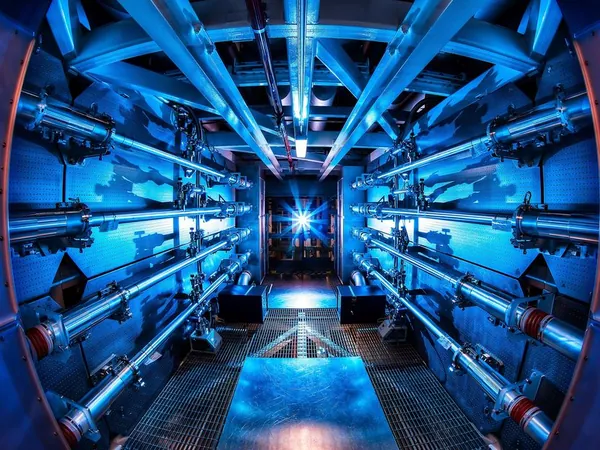
Unlocking the Secrets of Warm Dense Matter: A New Computational Breakthrough
2025-06-30
Author: Ming
The Enigma of Warm Dense Matter
Warm dense matter (WDM) is a fascinating state of matter that reaches mind-boggling temperatures of thousands to hundreds of millions of Kelvin, coupled with densities sometimes greater than those of solids. According to Dr. Tobias Dornheim, a junior group leader at CASUS, such extreme conditions exist in places like gas giants, brown dwarfs, and the atmospheres of white dwarfs. On Earth, WDM can be replicated during meteorite impacts and powerful laser experiments.
The Importance of WDM in Materials and Fusion Research
WDM is pivotal for materials research, exemplified by the creation of tiny diamonds from heated and compressed plastics. It also plays a crucial role in fusion research, particularly in laser-driven inertial confinement fusion at Lawrence Livermore National Laboratory (LLNL). As Dr. Tilo Döppner explains, in these fusion experiments, hydrogen isotopes undergo intense heating and compression via laser bombardment, leading to nuclear fusion and energy release. Understanding WDM is vital for achieving energy gains in these experiments.
Overcoming Computational Challenges: The Sign Problem
Simulating WDM can be tricky. Traditional methodologies face limitations due to the complexities of WDM as a transitional state between solid, liquid, and plasma. Dr. Maximilian Böhme notes that existing models often involve oversimplifications, lacking the accuracy needed for effective analysis.
Path integral Monte Carlo (PIMC) simulations could provide a more accurate description of WDM, yet they are stymied by the notorious 'sign problem'. This issue arises because the calculations involve aggregating the contributions from all electrons, but these contributions can oscillate between positive and negative values, potentially cancelling each other out and complicating precise calculations.
Innovative Solutions: Imaginary Particle Statistics
Dr. Dornheim and his team have introduced a novel solution by employing imaginary particle statistics. While these are not physically real, they help mitigate the sign problem, allowing for the first accurate use of PIMC simulations on a real material—beryllium. This groundbreaking approach marks a significant leap forward in computational materials science.
Bridging Theory and Practice: Experimental Validation
These innovative simulations have been bolstered by experimental work at LLNL, where Dr. Döppner has led efforts to compress beryllium capsules with 192 laser beams at NIF. By utilizing powerful X-rays, researchers studied how density and temperature changed during laser compression. The new method allows for a more accurate analysis of X-ray scattering data, revealing critical parameters that were previously underestimated.
Dr. Jan Vorberger from the Institute of Radiation Physics at HZDR emphasizes that their findings are crucial for better modeling of the hydrogen fusion process, potentially correcting past assumptions in fusion capsule simulations. This new diagnostic tool also paves the way for developing equations of state vital to fusion power plant designs and understanding exoplanets.
Looking Ahead: Future Experiments on the Horizon
In a bold step forward, the research team plans to conduct further experiments at NIF in the fall of 2025. Dr. Dornheim reveals their goals: to refine diagnostic techniques and assess the method's sensitivity to minute changes. The vision is to not only analyze but also optimize new experiments, enhancing the development of efficient fusion capsules.
This groundbreaking research involves collaboration among various institutions, including HZDR, LLNL, KTH in Stockholm, the University of Rostock, the Technical University of Dresden, the University of Warwick, and SLAC National Accelerator Laboratory.



 Brasil (PT)
Brasil (PT)
 Canada (EN)
Canada (EN)
 Chile (ES)
Chile (ES)
 Česko (CS)
Česko (CS)
 대한민국 (KO)
대한민국 (KO)
 España (ES)
España (ES)
 France (FR)
France (FR)
 Hong Kong (EN)
Hong Kong (EN)
 Italia (IT)
Italia (IT)
 日本 (JA)
日本 (JA)
 Magyarország (HU)
Magyarország (HU)
 Norge (NO)
Norge (NO)
 Polska (PL)
Polska (PL)
 Schweiz (DE)
Schweiz (DE)
 Singapore (EN)
Singapore (EN)
 Sverige (SV)
Sverige (SV)
 Suomi (FI)
Suomi (FI)
 Türkiye (TR)
Türkiye (TR)
 الإمارات العربية المتحدة (AR)
الإمارات العربية المتحدة (AR)